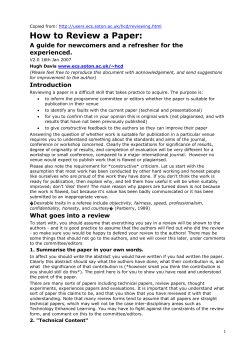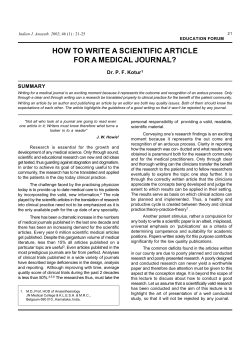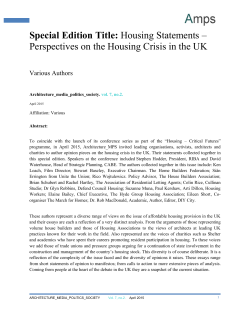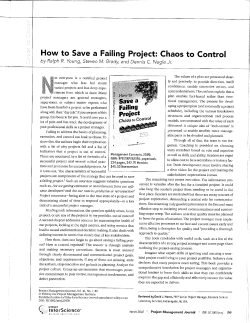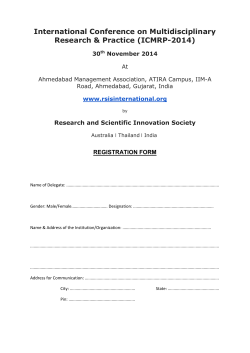
journal of the marine biological association - Assets
JOURNAL OF THE MARINE BIOLOGICAL ASSOCIATION INSTRUCTIONS TO AUTHORS Revised May 2015 Please read these instructions carefully Manuscripts submitted to the JMBA must be original, not under consideration elsewhere and approved by all authors and institutions prior to submission. Papers should be written in clear succinct English and sentences must not start with an abbreviation. Acronyms must be written in full on their first occurrence and SI units should be used. Scientific names must be italicized (not underlined) and their first mention after the Abstract must be followed by the Authority and date in parenthesis when appropriate. Manuscripts should be arranged in the following order: Running Head, Title, Author(s), Address(es), Abstract, Keywords, Introduction, Materials and Methods, Results, Discussion, Acknowledgements, References, Figure Legends, Tables and Appendices. Manuscripts which do not comply with publication standards of written English will be rejected on submission. Cambridge recommends that authors have their manuscripts checked by an English language native speaker before submission; this will ensure that submissions are judged at peer review exclusively on academic merit. We list a number of third-party services specialising in language editing and / or translation, and suggest that authors contact as appropriate. Use of any of these services is voluntary, and at the author's own expense. http://journals.cambridge.org/action/stream?pageId=8728&level=2 &menu=Authors&pageId=3608 Please note that the journal uses software to screen papers where there is reason to believe that material may not be original. By submitting your paper you are agreeing to any necessary originality checks your paper may have to undergo during the peer review and production processes. Submission. Please submit the manuscript for review to: http://mc.manuscriptcentral.com/jmba Suggested reviewers. Please suggest the names, institutions and e-mail addresses of up to four potential reviewers. Suggested reviewers should be selected from an INTERNATIONAL (at least three different countries) and not a LOCAL (from author(s) own country or laboratory) group of scientists in the research field of the paper. Experimental design. All studies must have been conducted in accordance with institutional, national and international guidelines concerning the use of animals in research and/or the sampling of endangered species. Preparation. The JMBA invites contributions as: 1. Research articles + figures + tables. 2. Reviews of current topics of interest. RESULTS (1st heading, upper case, left justified) then: The sampled population (2nd heading, bold, left justified) DENSITY AND BIOMASS (3rd heading, small caps, left justified) Reproduction and development (4th heading, lower case italics, left justified) DISCUSSION (1st heading, upper case, left justified). Subheadings, if used, should follow the instructions under RESULTS. ACKNOWLEDGMENTS (1st heading, upper case, left justified). You may acknowledge individuals or organizations that provided advice, support (non-financial). Formal financial support and funding should be listed in the following section. FINANCIAL SUPPORT. Please provide details of the sources of financial support of all authors, including grant numbers. For example, ‘This work was supported by the Medical Research Council (grant number XXXXXXX)’. Multiple grant numbers should be separated by a comma and space, and where research was funded by more than one agency, the different agencies should be separated by a semi-colon, with ‘and’ before the final funder. Grants held by different authors should be identified as belonging to individual authors by the authors’ initials. For example, ‘This work was supported by the Wellcome Trust (A.B., grant numbers XXXX, yyyy), (C.D., grant number ZZZZ); the Natural Environment Research Council (E.F., grant number FFFF); and the National Institutes of Health (A.B., grant number GGGG), (E.F., grant number HHHH)’. Where no specific funding has been provided for research, please provide the following statement: ‘This research received no specific grant from any funding agency, commercial or not-forprofit sectors’. Taxonomy should be presented as follows: SYSTEMATICS (1st heading, upper case, centre justified) Order AMPHIPODA Latreille, 1816 Suborder GAMMARIDEA Latreille, 1803 Family UROTHOIDAE Bousfield, 1978 Genus Carangolia Barnard, 1961 Carangolia barnardi sp. nov. (Figures 1–6) Carangolia spp.: Elizalde et al., 1993; Sorbe & Weber, 1995; Dauvin & Sorbe, 1995. (left justified) E-mail. Please provide an e-mail address for the corresponding author. This will appear on the title page of each article. Abstracts (italic font). A concise abstract should outline the scope, main results and conclusion(s) of the paper without discussion or authorities associated with species. Species name(s) will be roman (normal). TYPE M ATER IAL (taxon omic sub-headings, small caps, left justified) Holotype: adult female (oostegites developed) 2.69 mm, completely dissected and mounted on 12 slides. (OXYBENT VIII, TS05-R, N4; coordinates: 43°49.34′N 02°02.74′W; water depth: 550 m) (MNHN-Am5129); coll. J.-C. Sorbe, 19 April 1999. Paratype: adult male (penile papillae developed) 3.88 mm partially dissected, with both first antennae, maxillipeds, epimeral plates, pleopods, and second antenna and second gnathopod mounted on three slides; rest as five pieces preserved in 70% ethanol. (ECOMARGE 93, TS08-A, Ni; 44°34.57′N 02°12.60′W; water depth: 740–746 m) (MNHN-Am5130); coll. J.C. Sorbe, 23 June 1993. Twenty-one additional specimens in J.C. Sorbe Collection. Keywords. Please provide up to ten key words. COMPARATIVE MATERIAL EX AM INE D Title (bold font). Should be no more than 20 words with no authorities associated with the species. A running head of not more than 43 characters should be suggested. Authors addresses should follow the title. Use superscript numbers to indicate different addresses. Headings. Follow the style and hierarchy for each section as shown below (but see later for taxonomy): INTRODUCTION, MATERIALS heading, upper case, left justified). AND METHODS (1st Carangolia cornuta Bellan-Santini & Ledoyer, 1986. Holotype: female completely dissected on single slide (Museo Civico di Storia Naturale di Verona, slide no. 3276); RV ‘Marion Dufresne’ Cruise MD08 to Marion and Prince Edward Islands, Station 17BB97 (Marion Island: 46°52.5′S 37°53.5′E); collected on 25 March 1976 with Okean grab on muddy sand, 110 m depth. images of tables embedded in word files. DIAGNOSIS Carangolia with well developed pointed process on posterolateral corner of head. Coxal plate 1 with anterior and posterior margins subparallel, distal margin straight. Coxal plate 7 pointed. Basis of pereopod 6 slender, not oblong. Dactylus of pereiopod 5 elongate (more than 12 times longer than wide). Telson devoid of spines. KEY FOR THE GENERA OF THE ALVINOCARIDID AE Tables should not be excessive in size and headed by informative legends. Legend, headings and footnote are delimited by horizontal lines as shown in the example below; table headers are centred and roman (normal) typeface. Column headings are bold. The table below gives an example of layout: (small caps, left justified) 1. Posterior telson margin armed only with spines, without plumose seta…………………………………………….…..2 — Posterior telson margin armed with plumose setae……………………………….………………….……..3 (Insert a line space between each point) 2. Rostrum long, depressed laterally; pterygostomal spine present; lash on first maxilliped rudimentary…………………………………..….Alvinocaris — Rostrum short, compressed dorsoventrally, without teeth; pterygostomal spine absent; lash on first maxilliped well developed………………………….........................….Iorania 3. Short rostrum present; exposed eyes separated from each other; distolateral spine present on scaphocerite………………….…………...……...Chorocaris Text files should be submitted as line-numbered Microsoft Word files and should include Figure legends. Figures. Should be referred to in full in the body of the text (e.g. Figure 1). Figure legends should take the following style: Fig. 1. Ceratothoa collaris Schioedte & Meinert, 1883, adult female: (A) pereopod 1; (B) pereopod 7; (C–G) pleopods 1–5 ventral view; (H) uropods. Scale bars: A–G, 2 mm; H, 3 mm. Figures’ submission. IMAGES should be submitted as tif (preferably), jpg or png file-types. FIGURES SUPPLIED AS EMBEDDED OBJECTS IN MICROSOFT WORD OR AS PDF FILES CANNOT BE ACCEPTED. To ensure adequate print quality, please submit greyscale tif files NO LESS than 1200 pixels wide and NO MORE than 2500 pixels wide. These correspond to 300 dpi (118 pixels/cm) resolution at single (8.5 cm) and double (17.5 cm) column size respectively. The width should be checked in image editing software such as Photoshop, PaintShop Pro etc. Very high resolution images should be reduced to 2500 pixel width BEFORE submission to avoid uploading problems during submission. Colour images cost £200 (GBP) per page in print but are free in the online version. To have a colour image online and a greyscale version in print it is ESSENTIAL to submit BOTH greyscale and colour versions. THE JOURNAL WILL NOT CONVERT COLOUR IMAGES TO GREYSCALE. If you request colour figures in the printed version, you will be contacted by CCC-Rightslink who are acting on our behalf to collect Author Charges. Please follow their instructions in order to avoid any delay in the publication of your article. Failure to follow these guidelines may delay the processing of manuscripts. The bit depth should be set to 2-colour (1 bit) for black and white line drawings or greyscale (8 bit) for images incorporating shades of grey. Colour images may be of whichever depth is most suitable. Halftones should be grouped as composites or as individual pictures and a scanned electronic version submitted with the revised text. All figures should be labelled with a medium weight sans serif font of an appropriate size to result in 8 point (3.33 mm) type when reduced to published size. If figures are in parts, please label with upper case letters (A, B, C etc.) in the top left corner of each part. Tables should be submitted as Microsoft Word tables. the journal cannot accept text formatted with tab characters or Table 1. Tenacity of Elminius modestus and Balanus perforatus cypris larvae to natural biofilms developed at high (83 s-1) and low (15 s-1) shear rates. Forces of temporary adhesion are given as 104Nm-2. Eliminus modestus N Mean ±SE 30 8.19 0.258 30 7.59 0.274 30 9.20 0.219 Bartlett’s statistic = 1.44; P = 0.486 N, number; SE, standard error. Surface No biofilm Low shear High shear Balanus perforatus N Mean ±SE 30 6.75 0.179 30 4.94 0.136 30 6.50 0.162 Bartlett’s statistic = 2.79; P = 0.248 Failure to follow these guidelines may delay the processing of manuscripts. Genus and species names should be italicized and appear in full at each mention in a new section and if starting a sentence. In italicized text (Abstracts) species names should be normal typeface. Citation of literature. References in the text should refer to the author’s name (no initials) and year of publication. Two authors should be cited using ‘&’ (Rainbow & Dellinger, 1993); for more than two authors, the name of the first author followed by ‘et al.’ (Lallier et al., 1987). When citing more than one publication use date order and a semi-colon as a separator, e.g. (Mykels & Skinner, 1985a, b; Skinner, 1996; Gorind et al., 1997). The manuscript should be carefully checked to ensure the details of authors and dates cited in the text exactly match those in the reference list. Cross checking of references in the text to the cited literature and vice versa is the responsibility of the author. All literature quoted in the text must be listed in alph abetical and chronological order of author names at th e end of each manuscript. When more than one publication with the same first author is cited the following order alphabetically applies: (a) single author, according to publication dates; (b) same author and one co-author; (c) same author and more than one co-author. The style follows the full name according to the ‘World List of Scientific Periodicals’ latest edition, London. Titles of journals must be written in FULL (not abbreviated) and references to books should include the place of publication and the publisher. Dashes. Hyphen between connecting words; en-dash between ranges e.g. 3–10, B–G, and between opposite words e.g. male– female pairs, size–frequency, etc. REFERENCES (1st heading, upper case, left justified) Journals: Marshall S.M., Nicholls A.G. and Orr A.P. (1939) On the growth and feeding of young herring in the Clyde. Journal of the Marine Biological Association of the United Kingdom 23, 427–455. Books: Cushing D.H. (1981) Fisheries biology, a study in population dynamics. 2nd edition. Madison: University of Wisconsin Press. Chapters from books: Weir B.S. (1990) Intraspecific differentiation. In Hillis D.M. and Moritz C. (eds) Molecular systematics. Sunderland, MA: Sinauer Associates, pp. 373–410. Symposium proceedings: Cinelli F., Fresi E., Mazzella L., Pansini M., Pronzato R. and Svoboda A. (1977) Distribution of benthic phyto- and zoocoenoses along a light gradient in a superficial marine cave. In Keegan B.F., Ceidigh P.O. and Boaden P.J.S. (eds) Proceedings of the Eleventh European Symposium on Marine Biology, University College, Galway, 5–11 October 1976. Biology of benthic organisms. Oxford: Pergamon Press, pp. 173–183. Book series: El Haj A.J., Whiteley N.M. and Harrison P. (1992) Molecular regulation of muscle growth over the crustacean moult cycle. In El Haj A.J. (ed.) Molecular biology of muscle. Cambridge: Cambridge University Press, pp. 151–165. [SEB Seminar Series, no. 46.] O c c as i o n a l pub l i c a t i o n s : M oo r e P . G . ( 1984 ) T he f a una of t h e Cl yd e S e a ar e a . C r u s t a c ea : Amphipoda. University Marine Biological Station Millport, Occasional Publications, no. 2, 84 pp. Reports: Gaard E. (1987) An investigation of the squid Loligo forbesi Steenstrup on Faroe Bank. International Council for the Exploration of the Sea (CM Papers and Reports), CM 1987/K:18, 9 pp. Baird Jr F.T. (1953) Observations on the early life history of the giant scallop (Pecten magellanicus). Research Bulletin. Department of Sea and Shore Fisheries, Maine, no. 14, 7 pp. Theses: Leighton D.L. (1968) A comparative study of food selection and nutrition in the abalone, Haliotis rufescens Swainson, and the purple sea urchin, Strongylocentrotus purpuratus Stimpson. PhD thesis. University of California, San Diego, USA. Processing. Manuscripts will be assessed by an expert Associate Editor and their nominated referees. A decision will be made by the Associate Editor based on the referees’ reports and their opinions. Authors will be advised of the decision by e-mail from the ScholarOne system via http://mc.manuscriptcentral.com/jmba. If papers are sent back to the authors, for revision and for checking editorial corrections, they must be returned within three weeks. The acceptance date will appear on the first page of the published manuscript. Revised manuscripts and figures must be uploaded to: http ://mc.manu scrip tcentral.com/jmba Proofs. The corresponding author will receive the proofs by email as PDF files. Authors should send proof corrections by email to the administrator. Offprints. The contributing author will be provided with a PDF file of their article on publication. Extra printed offprints must be ordered before publication using the form provided with the proof.
© Copyright 2025




